There are many advantages to using a 24V or 48V battery bank rather than the more commonly found12 Volt. Primarily, the cable used to connect the alternator/generator to the battery bank, and from the battery bank to the load appliances can be thinner since line losses (energy lost as electricity passes through cable) are less the higher the voltage transmitted.
While affordable power inverters are available for use with 24V batteries and battery banks, other useful items are much more expensive if rated for use with 24VDC rather than 12VDC – for example, Sat-Nav chargers, LED lighting, and the huge array of items designed to be used in-car or with caravans and powered by 12 VDC.
Do-it-Yourself 24V to 12V Voltage Regulators
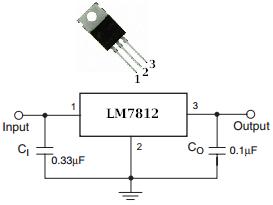
The simplest way of getting 12V from a 24V source is to use a linear voltage regulator. For low current applications the LM7812 (pictured above) is the obvious choice. The LM7812 is a three terminal positive regulator which takes in an input voltage of up to 35 Volts and will output 12 Volts. With sufficient heatsinking, it can supply up to 1 Amp.
For a slightly larger current output – up to 1.5 Amps, an LM317T adjustable voltage regulator can be used. Looking physically the same as the LM7812, the LM317T has an adjustable voltage output which is set using a couple of resistors whose values can be ascertained using our LM317 voltage calculator. (To obtain just over 12V, typically the resistor values used are R1=2K1 and R2=240.)
The common option for medium current 12V outputs is the LM338T. This three terminal adjustable voltage regulator is rated to output up to 5 Amps with sufficient heatsinking (and even higher currents for short bursts or with lots of heatsinking). As with the LM317T a couple of resistors are used to set the output voltage as required.
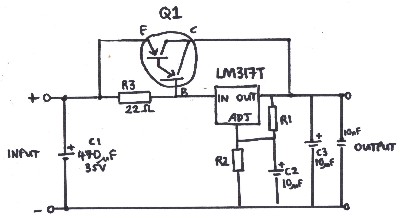
For high currents more complex circuits must be built, typically using a pass transistor. Pictured above is an example of such a circuit from our article LM317 High Current Voltage Regulator. The pass transistor (e.g. a PNP power darlington transistor) carries the vast majority of the current while the LM317T ensure steady regulation of voltage is maintained. Since the LM317T carries only a little current, it is the pass transistor which gets the heatsinking.
The linear regulators mentioned above are very cheap (under £2 each) and require virtually no external components, but they are also not very efficient. This means that they waste energy, and that energy is dissipated as heat which also has to be dealt with. The alternative is a switching/switch-moderegulator such as the LM2596T-12 3A 12V output step-down buck switching regulator pictured below.
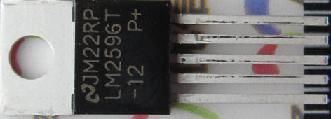
These are harder to find, are more expensive, and require more external components (see theLM2596T-12 datasheet here for details), but the finished regulator can be over 90% efficient instead of the 50% of a 24V-12V linear regulator. This can make a big difference – particularly with solar powered applications.
Commercial 24V to 12V DC-DC Converter
If you have a 24V lorry battery or a 24V battery bank, but you still want to be able to power 12VDC rated appliances, there are many DC-DC Converters on the market. These are designed to give a regulated 12VDC output from an input voltage of around 24V-30VDC. These are relatively cheap to purchase as there is a large market of lorry drivers who want to be able to use 12V rated kettles and televisions etc in their 24V wired cabs.
The key things to look for are the maximum load current rating (measured in Amps). This tells you how much current the connected 12V rated appliance can safely draw. The second is the efficiency. Ideally you do not want to be wasting stored battery charge as heat, so try to purchase the most efficient DC-DC converter you can afford.
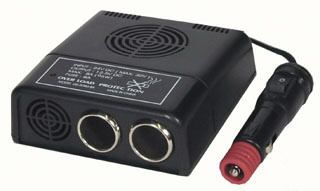
Pictured above is an 8 Amp rated 24V-12V DC-DC Converter. This has been designed to be plugged straight into the 24V cigar lighter socket in a lorry cab, but the plug can easily be cut off and the bare wires connected to a 24V battery bank. The two output sockets are for devices which can be powered directly from standard car 12V cigar lighter sockets. One device can be powered at up to 8 Amps (100 Watts), or two at up to 4 Amps each. The built in on/off switch is very useful for saving battery charge when no loads are present. These devices are priced from around £15.
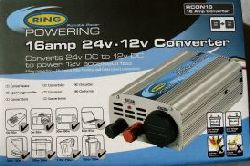
Pictured above is a higher quality, higher current rated 24-12V converter. Rated at 16 Amps (200 Watts), this can be used to power large laptop computers and 12V rated kettles with ease. It can accept inputs from 22-29 VDC, and uses just 30mA of current when not supplying an output.
Useful added features include low voltage protection (prevents battery being excessively drained), andover voltage protection (stops converter being damaged if connected to voltage source exceeding 29V.
Connections to this converter can be made by 12V sockets, pillar terminals, or the supplied cables.
These higher power rated units with additional features are priced from around £30.
Buy a 24-12V DC-DC Converter
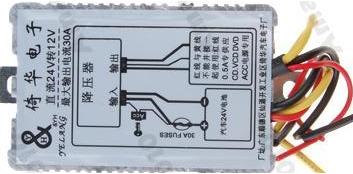
Click here for a wide selection of 24V to 12V Converters for use in vehicles. Over the last few years the number of cheap Chinese imports of these devices has increased enormously. The unit pictured above for example is a 30 Amp 24V-12V converter which is just £10 including UK delivery.